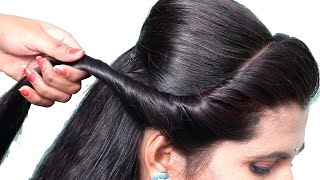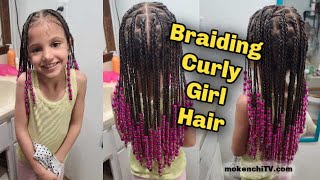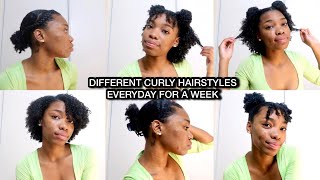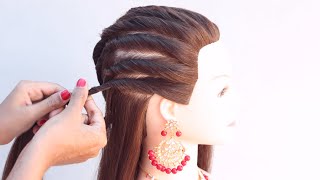Linkies Track Weave Hair Extension Tutorial
- Posted on 14 November, 2011
- Braids Hairstyles
- By Anonymous
Check out the new and improved version of this video at
Supply: doctoredlocks.com, Questions: [email protected]
A Linkies track weave THE alternative to braided weave extensions. Learn how to perform this installation with a professional finish.
Products Used:
Doctored Locks Linkies:
http://www.doctoredlocks.com/category/...
ECW European Straight Weaving Hair:
http://www.doctoredlocks.com/product/E...
Smooth Microclamp Closer Tool:
http://www.doctoredlocks.com/product/S...
Microneedle:
http://www.doctoredlocks.com/product/M...
Original Thin Weaving Thread:
http://www.doctoredlocks.com/product/O...
Curved Weaving Needle:
http://www.doctoredlocks.com/product/W...
Steps:
1. Put the Linkies onto the microneedle.
2. Carve off a section about an inch wide and ⅓ of an inch deep.
3. Split that section into two and slide a ring onto the first leg of the natural hair.
4. Go down through the Linkie and pick up the second leg.
5. Pull the legs so that they create an X through the ring.
6. Control the tension and placement by pulling the legs taut, and use your closer to clamp the ring into place.
7. Continue creating a row using this method.
8. The next step is to create the linking row. Take the legs from two neighboring bonds.
9. Slide the ring onto one of the legs, then go down through the Linkie, and pick up the neighboring leg.
10. Pull the legs so that they create an X.
11. Pull the two legs to control the tension, and use your closer to clamp the ring into place.
12. Continue until you have finished your linking row.
13. Cut your weft so that it is just slightly wider than your base row.
14. Cut a second piece of weft that is slightly shorter than your first.
15. Using your needle and thread, add one stitch to lock the two pieces together with your top weft extending slightly beyond your lower layer.
16. Sew the wefts to your Linkies base, starting slightly in from the edge and working back out to the edge.
17. Make sure to hold the natural hair legs back as you sew the weft in place.
18. Continue sewing until you reach the other end. Remember to pull the natural hair leg underneath and sew back away from the end to ensure a flat extension point.
19. Clip off your thread and create one simple knot with the ends.
20. Slide your microneedle underneath the base, and pull one of the legs of thread around.
21. Create several knots to secure your weft and clip away the remaining thread.
22. Continue adding rows you have create your desired style.
For more tricks, tips and hot deals "Like" us on Facebook!
http://fb.com/DoctoredLocksInc
For hair extension packages and tutorials, visit our website!
There are many benefits to using linkies for all of your weaving applications. First you're going to be able to provide a quick installation with maximum coverage, you're also going to be able to provide a stable base row. What that means is that there's not going to be any slippage so if you've ever had a braided installation that slipped out over time, you'll know what I'm talking about. Lastly, you're going to be able to control the tension at every single link in the process to begin you're going to need, link ease and the color that matches your route layer or slightly darker you'll need a micro needle you'll need closers, a weaving needle and thread, And, of course, your extension hair to begin you're going to thread your rings onto your needle carve off a section of hair with your needle. That is about an inch wide and about a third of an inch deep make sure that you don't have any cross hairs. Next carve that section into two from this point forward, I'm going to call these legs you're, going to pick up your first leg and slide a ring onto the natural hair. Next you're going to go down through that linkie and pick up the second leg of hair. I'M going to pull that so that it creates an X by holding the two legs out, then adjusting the tension make sure that I have a little bit of movement so that it's not super tight to the scalp and we're going to flatten that into place. You want to have a little bit of play in there to make sure that this isn't going to be too tight. Remember you're also going to be sewing on top of this. So that's really important. Okay, you're, going to take over the neighboring section again inch wide bottom third of an inch deep make sure that there's no cross hairs split that section into two pick up your first leg, pull it into the ring, go back down through the ring. Pick up. Your second leg hold the legs away from the center, adjust the tension with your closer and close continue. This until you've created your entire base row. The next step is to create your linking row pick up the two legs slide. The link on to the first leg go back down through the link and pick up that second leg again: you're creating an X just like you did in the first row, use your closing tool to adjust the tension and crimp that into place again. You should have a bit of movement continue to link neighboring sections until you have completed your linking row. The next step is to apply your extension hair you're, going to cut your weft so that it fits just beyond your base. Row, you're also going to add a coverage layer that coverage layer needs to be slightly shorter than your main extension piece to begin. Lock these rows, together with your weaving thread. You want your top extension layer to extend beyond your coverage layer so that these ends create a nice smooth transition. Go underneath your base row and also underneath your thread since we'll be going out to the end. We'Ll want to pull your first leg underneath so that it doesn't stick out start at the interior work. Your way out towards the ends then work your way back towards the interior of your weft. When you get to the second end, do the same thing: pull the leg underneath and so out to the edge. So until your edge is secured, then do a couple stitches back towards the interior. This will allow your knots to remain on the inside and not at your transition. Points to tie off first create one simple knot, then, with your needle go underneath the weft and pull one of the legs of thread around using these two legs of thread. Do several knots to secure your weft clip away any remaining thread? This can be used for accent panels or for a full installation continue until you have finished your desired style. You





Comments
Doctored Locks: Thanks. I created this method years ago when people were sewing the rings to the weft instead. This meant having to premeasure for your clients and having them come back after you had sewn on all of their rings. This also stabilized the track so it felt more solid - more like a cornrow - but with less tension. This is my absolute favorite method. I'm glad you liked it. :)
cjcountessa: This video IS great. I have actually used this technique (on myself) with a double weft full sewn install. This is by far the best technique i've used. This technique does not slip AT ALL. I used to get the hair sewn to braids, but i wanted to try this technique and glad i did. I can wear a high pony tail, half up & down, chignon bun, it's endless.
Doctored Locks: It's one of my favorite methods of all time. So comfortable and easy to maintain. :) Glad you like it.
Doctored Locks: Yes, absolutely. You just need to watch your placement. You'll want to stay away from the sides and bottom so that when the hair is pulled up, that there is enough hair to cover your rows. Also, it may be a little tight the first few days, so while it is possible, a looser ponytail may be advised for the first week. :)
Mary Sukumari: Excellent teaching mam! When learnt it also creates job opportunities !! Thanks for expertise
Juliana Ribeiro: Wow!!! I loved it! :)
Isabela Cabral: It keeps the weaves closest to the root. Awesome!
Roxanne Enemokwu: thank you for this demo, watched it last night and did a side fringe parting for my afro-carribean hair type client to add length and colour to her hair and she loves it, just waiting to see how long she can keep it in for. Please advise me, to do a full head, what is the best placement i.e brick laying type, panel by panel or continuous track/ row?. i,e a client can have 4/5 tracks double wefts or each track cuts down, Sorry if this sounds confusing....
florence ward: perfect demo, most of videos on the net are total ......., I am a extensions technician and I use this method a lot. You know what you are doing, great job
georgina0661: Great method if done properly how long can they last?
cleches: Great vid! Have you known anyone to do this on themselves?
cammey3: I have the loops attached to the wefts already, I find it easier and better
piscisjo: thx u! looks very nice..i only need to know where can i buy thread and needles.cant wait to try it :)
Christeena Creager: this is SOOOOO COOL!!!
Doctored Locks: You can definitely use this method with 3 to 5 inches or even shorter. The problem with hair that is too short is that you might have a hard time blending it. Going with exaggerated layers or blending with shorter extension hair can help. Another option is to buy a top piece. We have some awesome ones called a "Masterpiece" - and they work really well and are under $20. :)
Doctored Locks: We have all of the supplies on our website. doctoredlocks (dot) com - needles, thread, links and tools. :)
Anna Leah: i couldnt imagine more uncomfortable extentions in my hair.
Maricruz N. A.: Great video~ :D her voice reminds me of the voice-overs from the E.L.F cosmetics videos :3
Doctored Locks: It can be done, but it VERY difficult!
Doctored Locks: Your style will grow out before they tracks give out. Generally 1 to 1.5 months before they are annoyingly loose. :)
Cyndie Lyons: Can this work on short haIr 3-5 inches long?
I_am mariami: I dont think the thread is something good for your hair. the thread will not cut the hair on the long term?